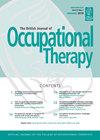Prioritising patients for hospital occupational therapy to reduce inpatient falls: A retrospective case-control study to identify predictive patient falls risk factors
IF 1.3
4区 医学
Q3 REHABILITATION
引用次数: 0
Abstract
Prompt identification of patients susceptible to falls is required by occupational therapists to initiate early falls prevention and management strategies. This study identified the intrinsic and extrinsic risk factors of patients who experience early inpatient falls (within 48 hours of admission). A retrospective case-control study was completed at a tertiary hospital. Data were extracted from medical records. Adults aged 18 years and older, admitted with any diagnosis, to any ward within the hospital between July 2019 and June 2020 were included. Cases were identified as those who fell within 48 hours of admission and controls did not experience a fall. The study sample included 218 patients (109 cases and 109 control patients). Most falls occurred in the patient’s room ( n = 54) or bathroom ( n = 47), as a result of slipping ( n = 50) or while patients were toileting ( n = 32). Multivariate regression analysis identified significant predictors of inpatient falls, including unassisted mobilisation (odds ratio (OR) 5.25), impaired balance (OR 7.25), reduced muscle strength (OR 5.25) and impulsivity (OR 19.57). Receiving occupational therapy reduced risk of falling by 81%. Falls risk factors that are predictive of early inpatient falls should be identified at admission and used to prioritise patients for occupational therapy.优先考虑住院患者的职业治疗,以减少住院患者跌倒:一项回顾性病例对照研究,以确定预测患者跌倒的危险因素
职业治疗师需要及时识别易跌倒的患者,以启动早期跌倒预防和管理策略。本研究确定了早期住院跌倒患者的内在和外在风险因素(48 入院时间)。在一家三级医院完成了一项回顾性病例对照研究。数据是从医疗记录中提取的。18岁的成年人 包括2019年7月至2020年6月期间因任何诊断而入住医院任何病房的岁及以上患者。病例被确定为48例以内 入院数小时和对照组均未出现下降。研究样本包括218名患者(109名患者和109名对照患者)。大多数跌倒发生在患者的房间(n = 54)或浴室(n = 47),作为滑动的结果(n = 50)或患者如厕时(n = 32)。多元回归分析确定了住院患者跌倒的重要预测因素,包括无辅助活动(比值比(OR)5.25)、平衡受损(OR 7.25)、肌肉力量下降(OR 5.25)和冲动(OR 19.57)。接受职业治疗可将跌倒风险降低81%。预测早期住院患者跌倒的跌倒风险因素应在入院时确定,并用于优先考虑患者进行职业治疗。
本文章由计算机程序翻译,如有差异,请以英文原文为准。
求助全文
约1分钟内获得全文
求助全文
来源期刊

British Journal of Occupational Therapy
REHABILITATION-
CiteScore
2.20
自引率
15.40%
发文量
81
审稿时长
6-12 weeks
期刊介绍:
British Journal of Occupational Therapy (BJOT) is the official journal of the Royal College of Occupational Therapists. Its purpose is to publish articles with international relevance that advance knowledge in research, practice, education, and management in occupational therapy. It is a monthly peer reviewed publication that disseminates evidence on the effectiveness, benefit, and value of occupational therapy so that occupational therapists, service users, and key stakeholders can make informed decisions. BJOT publishes research articles, reviews, practice analyses, opinion pieces, editorials, letters to the editor and book reviews. It also regularly publishes special issues on topics relevant to occupational therapy.
 求助内容:
求助内容: 应助结果提醒方式:
应助结果提醒方式:


